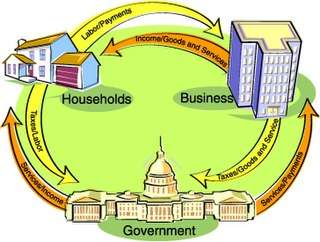Adaptive expectations
In economics, adaptive expectations is a hypothesized process by which people form their expectations about what will happen in the future based on what has happened in the past. For example, if inflation has been higher than expected in the past, people would revise expectations for the future.
One simple version of adaptive expectations is stated in the following equation, where is the next year's rate of inflation that is currently expected; is this year's rate of inflation that was expected last year; and is this year's actual rate of inflation:
where is between 0 and 1. This says that current expectations of future inflation reflect past expectations and an "error-adjustment" term, in which current expectations are raised (or lowered) according to the gap between actual inflation and previous expectations. This error-adjustment is also called "partial adjustment."
The theory of adaptive expectations can be applied to all previous periods so that current inflationary expectations equal:
where equals actual inflation years in the past. Thus, current expected inflation reflects a weighted average of all past inflation, where the weights get smaller and smaller as we move further in the past.
Once a forecasting error is made by agents, due to a stochastic shock, they will be unable to correctly forecast the price level again even if the price level experiences no further shocks since they only ever incorporate part of their errors. The backward nature of expectation formulation and the resultant systematic errors made by agents (see Cobweb model) was unsatisfactory to economists such as John Muth, who was pivotal in the development of an alternative model of how expectations are formed, called rational expectations. This has largely replaced adaptive expectations in macroeconomic theory since its assumption of optimality of expectations is consistent with economic theory. However, it must be stressed that confronting adaptivity and rationality is not necessarily justified, in other words, there are situations in which following the adaptive scheme is a rational response.
Adaptive expectations were instrumental in the Phillips curve outlined by Milton Friedman. For Friedman, workers form adaptive expectations, so the government can easily surprise them through unexpected monetary policy changes. As agents are trapped by the money illusion, they are unable to correctly perceive price and wage dynamics, so, for Friedman, unemployment can always be reduced through monetary expansions. The result is an increasing level of inflation if the government chooses to fix unemployment at a low rate for an extended period of time. However, in this framework it is clear why and how adaptive expectations are problematic. Agents are arbitrarily supposed to ignore sources of information which, otherwise, would affect their expectations. For example, government announcements are such sources: agents are expected to modify their expectations and break with the former trends when changes in economic policy necessitate it. This is the reason why the theory of adaptive expectations is often regarded as a deviation from the rational tradition of economics.[1]
See also
- Policy ineffectiveness proposition
- Problem of induction
- Rational expectations
- Self-fulfilling prophecy
- Cobweb model
References
- Galbács, Peter (2015). The Theory of New Classical Macroeconomics. A Positive Critique. Contributions to Economics. Heidelberg/New York/Dordrecht/London: Springer. doi:10.1007/978-3-319-17578-2. ISBN 978-3-319-17578-2.
- George W. Evans and Seppo Honkapohja (2001), Learning and Expectations in Macroeconomics. Princeton University Press, ISBN 978-0-691-04921-2.
